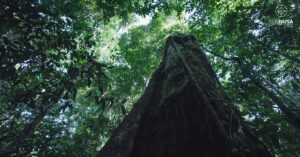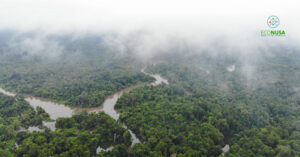
Primary forest and healthy marine ecosystem are the priceless natural resources affluence to Kaimana Regency. The local farmers and fishermen from the surrounding villages manage the richness for their own needs (subsystem). Rapid assessment conducted by EcoNusa Team on 11-19 October 2019 found that Kaimana has some potentials from banana, nutmeg, red snapper, local crab (karaka) and lobster. As a matter of fact, there are many more local potentials that remain concealed.
Regarding the potentials, the Kaimana’s Village Community Empowerment Office is facilitating the villagers to manage natural resources. As to Joice M. Tuanakotta, Head of the Kaimana’s Village Community Empowerment Office, the management is traditional in nature with local wisdom so the sustainability of commodities is well-conserved.
Joice said that the young villagers as the main human resources need capacity building. She expected that EcoNusa improves the capacity of village apparatus and human resources at village level so as to comprehend their own natural resources potentials. “EcoNusa must not simply build a warehouse but also provide an added value of the commodity so as to create multifarious products,” said Joice.
EcoNusa’s Program Director, Muhammad Farid, considered that young people should take more parts in this resources management. There is indeed trend that local young people prefers to work as a civil servant rather than private sector. None is interested in entrepreneurship or becoming an entrepreneur. “Young people or millennial generations should have knowledge on entrepreneurship and how to run their own business,” Farid said.
Based on the statistic of Kaimana Regency in 2019, the number of millennial generation of 16-30 years of age is 12,095 distributed in 84 villages. Considering the fact, it is necessary to empower young villagers which leads them to take part in natural resources management in their villages. But, the fact shows different thing when Papuan women dominate the management and production of grey banana in Tanggaromi Village, Kaimana District, in which EcoNusa pioneers its initiative. In Murano Village, seaweed cultivation is done by families without youth involvement. Namatota Village as tourism destination and Edoor Village cultivate vegetables and mangrove crabs. But, there is no optimum youth participation in both villages.
In addition, almost all villages have local potentials such as handicraft for tomang or noken production. Actually, handicraft could serve as way to lure more involvement of young villagers. If it works out, then one village could produce on prominent product.
Farid said that to generate young villagers’ interests, EcoNusa in cooperation with the local government plans to provide training on business incubator, cooperative or Village-owned Enterprise (BumDes) and to establish a forum or learning network for commodity in Kaimana Regency. “With the training, we believe that millennial generation in the village could give contribution to the management of natural resources from forest and marine in sustainable way through technology so as to ensure forest and marine ecosystem are well-conserved. The communication forum is very important as a way to give reinforcement through knowledge sharing among young farmers and fishermen in Kaimana Regency from and to other regencies in the Land of Papua and other provinces in Indonesia,” said Farid.
Authors: Ervin Sotter dan Aloysius Numberi
Editor: Leo Wahyudi







